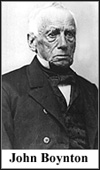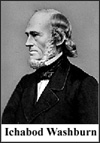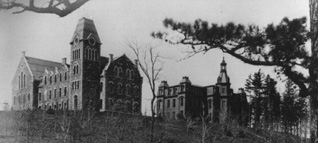Founding of the Institute

Throughout the centuries America has had colleges that excel in the professions of law, medicine, and theology. However, the first American polytechnic school (Rensselaer Polytechnic Institute) was not founded until 1824. Within three decades, the Lawrence Scientific School at Harvard, the Sheffield Scientific School at Yale, and Dartmouth’s Chandler School of Science had appeared as the new "science schools" of their universities. But the most dramatically different college aimed at meeting the need for uniting the theory and practice of engineering was yet to be born. That school would soon take shape in Worcester.

The concept for this new school was a product of the times and the convergence of the ideas of two men. Worcester Polytechnic Institute was the synthesis of the idealism of a self-made tinware manufacturer, John Boynton, and the highly specific ideas of Ichabod Washburn, owner of the world’s largest wire mill. Boynton, although wealthy, was uneducated and had never really been accepted into the society of the day. He envisioned science schooling that would elevate the social position of the mechanic and manufacturer, but not necessarily teach the skills needed to become either. Washburn, on the other hand, wanted to teach tech nical skills through a sophisticated apprenticeship approach.
When Boynton was finally ready to act, he traveled to consult his cousin (and former business partner) David Whitcomb as to ways and means of giving his dream effect. Whitcomb had no plan to suggest but with Boynton’s consent, he carried the dream to the man in whose wisdom he placed most reliance, his pastor, Seth Sweetser. By chance it happened that Ichabod Washburn had previously consulted Sweetser about the proper way to actualize a vision of his own, one similar enough to John Boynton’s dream to make Sweetser rub his eyes with astonishment when Whitcomb unfolded his cousin’s vision.

Washburn was shocked and unhappy when he heard about Boynton’s offer to create a college, for he had wanted to start a technical school of his own design as early as 1857. He had talked to President Barnas Sears of Brown University about it, but a series of tragic deaths in Washburn’s family and the advent of the Civil War deterred him. Some in the city were concerned about what kind of school the strongwilled Washburn might create. Later, there was some speculation that the concern might have figured in the timing of Boynton’s gift.
Sweetser’s task was a difficult and delicate one. The desires of these two men, with all their similarities, could not easily be harmonized and there were possible jealousies to be considered and avoided. It is to the wisdom of Sweetser, and to his diplomacy in dealing with the two men, that WPI is largely indebted for the particular shape it took at the beginning, a shape that its leaders have never seen fit to alter in any material way.
Although Washburn claimed, "I prefer to be imposed upon by others rather than by myself in withholding where I ought to give," he agreed to build, furnish, and endow a "Department of Practical Mechanics" at Boynton’s school. He specified, however, that every student should blend theory learned in the classroom with practice in the shops.
It was Sweetser who drafted a letter expressing Boynton’s tenacious wish to other significant men within Worcester County. The original version was submitted to Governor Emory Washburn for revision. When Washburn saw the draft, he made a few penciled suggestions with the remark, "It is perfectly intelligible as it is.” Later when Boynton approved the letter he said, "That meets my view exactly." With the letter in hand, Emory Washburn and Seth Sweetser decided it was time to talk to Stephen Salisbury II, a respected Worcester businessman. The document was then sent to 30 Worcester men. It told of a "liberal proposal to found a Free School for Industrial Science" in Worcester and called for a meeting later in the month.

On March 27, 1865, the men to whom the introductory letter had been sent attended a meeting in George Frisbie Hoar’s office. Hoar, a young lawyer in the Massachusetts state Senate, had taken over Emory Washburn’s office when the latter had become governor. At this meeting, Hoar and Sweetser were named corporators for the contemplated legislation. Two days later, the following notice appeared in the Worcester Palladium:
A Gentleman, who for the present withholds his name from the public, offers a fund of $100,000 for the establishment of a scientific school in Worcester, upon the condition that our citizens shall furnish the necessary land and buildings.
In response to this anonymous request, more than 225 Worcester citizens and the workers at 20 of the city’s factories and machine shops contributed to the construction of the original building. On May 10, 1865, after House and Senate approval, the secretary of the commonwealth recorded the Institute as a legal corporation, and it came into formal existence.

Less than one month later, on June 3, the corporators invited a few associates to meet with them to accept the charter, to organize the board, and to thank Boynton for his gift. Boynton had requested that the first board be selected by him. At this time, Stephen Salisbury II was elected president and David Whitcomb, Ichabod Washburn, Emory Washburn, and Seth Sweetser were named to the board.
In March of 1867, Boynton set out from Worcester to Templeton, Mass., in a sleigh and was caught in a severe blizzard. He developed pneumonia and died on the March 25. The new building had not yet been named. In fact, Boynton’s role in the new school’s development was a deep secret, unknown outside of the board. With his death, the secret was revealed and the building was named for him.
More than a year later, Washburn suffered a massive stroke. Neither man saw the opening of the college on November 11, 1868. On that day, Charles O. Thompson, the first president of the Institute, and Charles H. Morgan, the trustee in charge of the Washburn Shops, stood before WPI’s first two buildings with their distinctive towers that even then symbolized the institution’s two educational objectives of theory and practice, and inaugurated the Worcester County Free Institute of Industrial Science.
Maintained by webmaster@wpi.edu